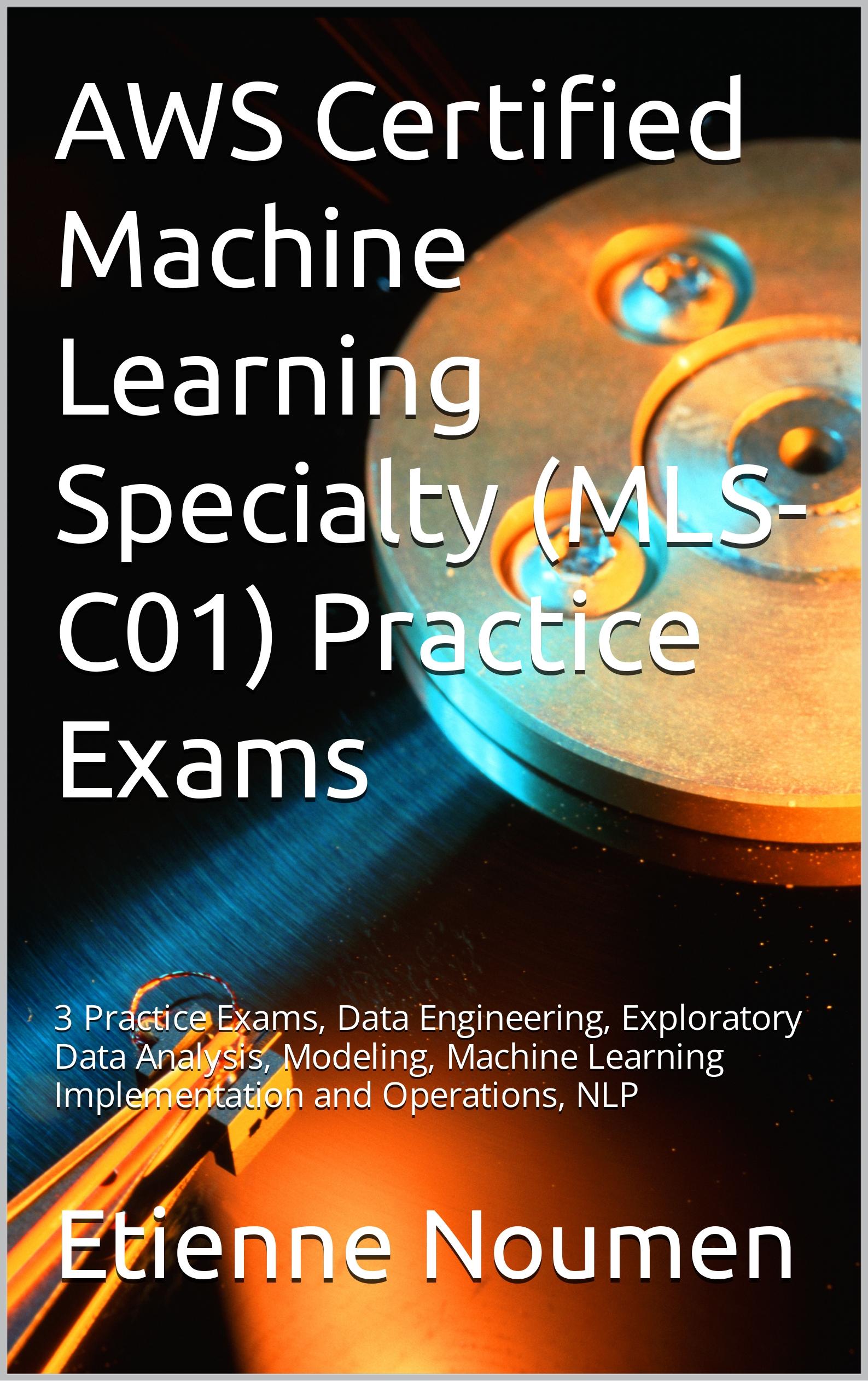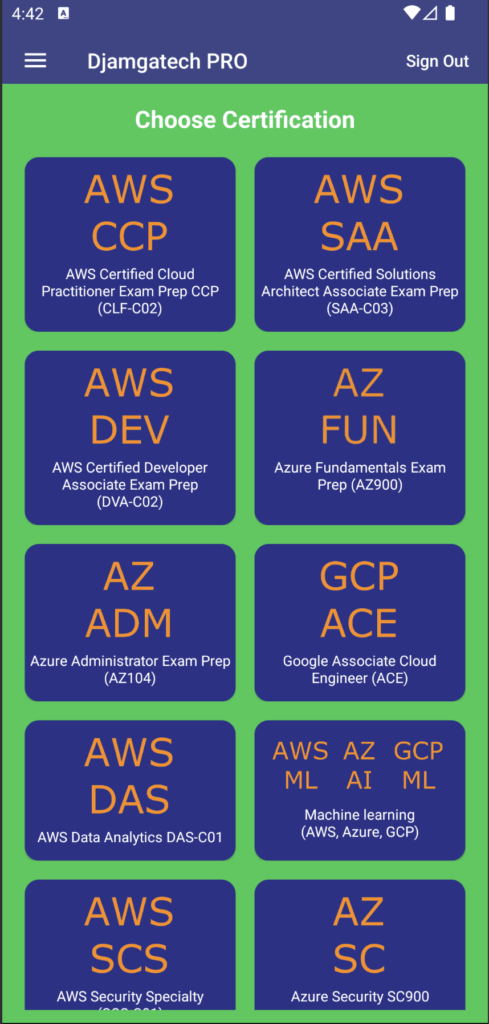AI Dashboard is available on the Web, Apple, Google, and Microsoft, PRO version
AWS Certification Preparation: AWS Ec2 Facts, Faqs and Summaries, Top 10 Questions and Answers Dump
AWS Ec2 Facts and summaries, AWS Ec2 Top 10 Questions and Answers Dump
Definition 1: Amazon Elastic Compute Cloud (Amazon EC2) is a web service that provides secure, resizable compute capacity in the cloud. It is designed to make web-scale cloud computing easier for developers.
Definition 2: Amazon Elastic Compute Cloud (EC2) forms a central part of Amazon.com’s cloud-computing platform, Amazon Web Services (AWS), by allowing users to rent virtual computers on which to run their own computer applications.
AWS Ec2 Facts and summaries
- Can users SSH to EC2 instances using their AWS user name and password?
No. User security credentials created with IAM are not supported for direct authentication to customer EC2 instances. Managing EC2 SSH credentials is the customer’s responsibility within the EC2 console.
- Amazon Elastic Compute Cloud (Amazon EC2) is a web service that provides resizable compute capacity in the cloud. It is designed to make web-scale computing easier for developers.
What is the difference between using the local instance store and Amazon Elastic Block Store (Amazon EBS) for the root device?
When you launch your Amazon EC2 instances you have the ability to store your root device data on Amazon EBS or the local instance store. By using Amazon EBS, data on the root device will persist independently from the lifetime of the instance. This enables you to stop and restart the instance at a subsequent time, which is similar to shutting down your laptop and restarting it when you need it again.
Alternatively, the local instance store only persists during the life of the instance. This is an inexpensive way to launch instances where data is not stored to the root device. For example, some customers use this option to run large web sites where each instance is a clone to handle web traffic.
How many instances can I run in Amazon EC2?
You are limited to running up to a total of 20 On-Demand instances across the instance family, purchasing 20 Reserved Instances, and requesting Spot Instances per your dynamic Spot limit per region.
How quickly can I scale my capacity both up and down?
Amazon EC2 provides a truly elastic computing environment. Amazon EC2 enables you to increase or decrease capacity within minutes, not hours or days. You can commission one, hundreds or even thousands of server instances simultaneously. When you need more instances, you simply call RunInstances, and Amazon EC2 will typically set up your new instances in a matter of minutes. Of course, because this is all controlled with web service APIs, your application can automatically scale itself up and down depending on its needs.
- When dealing with session state in EC2-based applications using Elastic load balancers which option is generally thought of as the best practice for managing user sessions?
Having the ELB distribute traffic to all EC2 instances and then having the instance check a caching solution like ElastiCache running Redis or Memcached for session information
- What is one key difference between an Amazon EBS-backed and an instance-store backed instance?
Amazon EBS-backed instances can be stopped and restarted without losing data
- How is the AWS Ec2 service different than a plain hosting service?
Traditional hosting services generally provide a pre-configured resource for a fixed amount of time and at a predetermined cost. Amazon EC2 differs fundamentally in the flexibility, control and significant cost savings it offers developers, allowing them to treat Amazon EC2 as their own personal data center with the benefit of Amazon.com’s robust infrastructure.
When computing requirements unexpectedly change (up or down), Amazon EC2 can instantly respond, meaning that developers have the ability to control how many resources are in use at any given point in time. In contrast, traditional hosting services generally provide a fixed number of resources for a fixed amount of time, meaning that users have a limited ability to easily respond when their usage is rapidly changing, unpredictable, or is known to experience large peaks at various intervals.
Secondly, many hosting services don’t provide full control over the compute resources being provided. Using Amazon EC2, developers can choose not only to initiate or shut down instances at any time, they can completely customize the configuration of their instances to suit their needs – and change it at any time. Most hosting services cater more towards groups of users with similar system requirements, and so offer limited ability to change these.
Finally, with Amazon EC2 developers enjoy the benefit of paying only for their actual resource consumption – and at very low rates. Most hosting services require users to pay a fixed, up-front fee irrespective of their actual computing power used, and so users risk overbuying resources to compensate for the inability to quickly scale up resources within a short time frame.
What load balancing options does the Elastic Load Balancing service offer?
Elastic Load Balancing offers two types of load balancers that both feature high availability, automatic scaling, and robust security. These include the Classic Load Balancer that routes traffic based on either application or network level information, and the Application Load Balancer that routes traffic based on advanced application level information that includes the content of the request.
When should I use the Classic Load Balancer and when should I use the Application Load Balancer?
The Classic Load Balancer is ideal for simple load balancing of traffic across multiple EC2 instances, while the Application Load Balancer is ideal for applications needing advanced routing capabilities, microservices, and container-based architectures. Please visit Elastic Load Balancing for more information.
Can I get a history of all EC2 API calls made on my account for security analysis and operational troubleshooting purposes?
Yes. To receive a history of all EC2 API calls (including VPC and EBS) made on your account, you simply turn on CloudTrail in the AWS Management Console. For more information, visit the CloudTrail home page.
How to get information about Ec2 instance type?
AWS EC2 Instance info- Can I access the metrics data for a terminated Amazon EC2 instance or a deleted Elastic Load Balancer?
Yes. Amazon CloudWatch stores metrics for terminated Amazon EC2 instances or deleted Elastic Load Balancers for 2 weeks.
Top
Reference: AWS Ec2 Faqs
Get 20% off Google Google Workspace (Google Meet) Standard Plan with the following codes: 96DRHDRA9J7GTN6
 Get 20% off Google Workspace (Google Meet) Business Plan (AMERICAS): M9HNXHX3WC9H7YE (Email us for more codes)
Get 20% off Google Workspace (Google Meet) Business Plan (AMERICAS): M9HNXHX3WC9H7YE (Email us for more codes)
Active Anti-Aging Eye Gel, Reduces Dark Circles, Puffy Eyes, Crow's Feet and Fine Lines & Wrinkles, Packed with Hyaluronic Acid & Age Defying Botanicals

AWS Ec2 Top 10 Questions and Answers Dump
Q0:
When dealing with session state in EC2-based applications using Elastic load balancers which option is generally thought of as the best practice for managing user sessions?
- A. Having the ELB distribute traffic to all EC2 instances and then having the instance check a caching solution like ElastiCache running Redis or Memcached for session information
- B. Permanently assigning users to specific instances and always routing their traffic to those instances
- C. Using Application-generated cookies to tie a user session to a particular instance for the cookie duration
- D. Using Elastic Load Balancer generated cookies to tie a user session to a particular instance
Top
Q2: You are attempting to SSH into an EC2 instance that is located in a public subnet. However, you are currently receiving a timeout error trying to connect. What could be a possible cause of this connection issue?
- A. The security group associated with the EC2 instance has an inbound rule that allows SSH traffic, but does not have an outbound rule that allows SSH traffic.
- B. The security group associated with the EC2 instance has an inbound rule that allows SSH traffic AND has an outbound rule that explicitly denies SSH traffic.
- C. The security group associated with the EC2 instance has an inbound rule that allows SSH traffic AND the associated NACL has both an inbound and outbound rule that allows SSH traffic.
- D. The security group associated with the EC2 instance does not have an inbound rule that allows SSH traffic AND the associated NACL does not have an outbound rule that allows SSH traffic.
Top
Q3: Which API call would best be used to describe an Amazon Machine Image?
- A. ami-describe-image
- B. ami-describe-images
- C. DescribeImage
- D. DescribeImages
Q4: What is one key difference between an Amazon EBS-backed and an instance-store backed instance?
- A. Autoscaling requires using Amazon EBS-backed instances
- B. Virtual Private Cloud requires EBS backed instances
- C. Amazon EBS-backed instances can be stopped and restarted without losing data
- D. Instance-store backed instances can be stopped and restarted without losing data
Q15: After having created a new Linux instance on Amazon EC2, and downloaded the .pem file (called Toto.pem) you try and SSH into your IP address (54.1.132.33) using the following command.
ssh -i my_key.pem ec2-user@52.2.222.22
However you receive the following error.
@@@@@@@@ WARNING: UNPROTECTED PRIVATE KEY FILE! @ @@@@@@@@@@@@@@@@@@@
What is the most probable reason for this and how can you fix it?
- A. You do not have root access on your terminal and need to use the sudo option for this to work.
- B. You do not have enough permissions to perform the operation.
- C. Your key file is encrypted. You need to use the -u option for unencrypted not the -i option.
- D. Your key file must not be publicly viewable for SSH to work. You need to modify your .pem file to limit permissions.
Q5: You have an EBS root device on /dev/sda1 on one of your EC2 instances. You are having trouble with this particular instance and you need to either Stop/Start, Reboot or Terminate the instance but you do NOT want to lose any data that you have stored on /dev/sda1. However, you are unsure if changing the instance state in any of the aforementioned ways will cause you to lose data stored on the EBS volume. Which of the below statements best describes the effect each change of instance state would have on the data you have stored on /dev/sda1?
- A. Whether you stop/start, reboot or terminate the instance it does not matter because data on an EBS volume is not ephemeral and the data will not be lost regardless of what method is used.
- B. If you stop/start the instance the data will not be lost. However if you either terminate or reboot the instance the data will be lost.
- C. Whether you stop/start, reboot or terminate the instance it does not matter because data on an EBS volume is ephemeral and it will be lost no matter what method is used.
- D. The data will be lost if you terminate the instance, however the data will remain on /dev/sda1 if you reboot or stop/start the instance because data on an EBS volume is not ephemeral.
Q6: EC2 instances are launched from Amazon Machine Images (AMIs). A given public AMI:
- A. Can only be used to launch EC2 instances in the same AWS availability zone as the AMI is stored
- B. Can only be used to launch EC2 instances in the same country as the AMI is stored
- C. Can only be used to launch EC2 instances in the same AWS region as the AMI is stored
- D. Can be used to launch EC2 instances in any AWS region
Q7: Which of the following statements is true about the Elastic File System (EFS)?
- A. EFS can scale out to meet capacity requirements and scale back down when no longer needed
- B. EFS can be used by multiple EC2 instances simultaneously
- C. EFS cannot be used by an instance using EBS
- D. EFS can be configured on an instance before launch just like an IAM role or EBS volumes
Q8: You are in charge of deploying an application that will be hosted on an EC2 Instance and sit behind an Elastic Load balancer. You have been requested to monitor the incoming connections to the Elastic Load Balancer. Which of the below options can suffice this requirement?
- A. Use AWS CloudTrail with your load balancer
- B. Enable access logs on the load balancer
- C. Use a CloudWatch Logs Agent
- D. Create a custom metric CloudWatch lter on your load balancer
Top
Q9: When deploying application code to EC2, the AppSpec file can be written in which language?
- A. JSON
- B. JSON or YAML
- C. XML
- D. YAML
Q9:
- A.
- B.
- C.
- D.
Top
Q10:
- A.
- B.
- C.
- D.
Top
Other AWS Facts and Summaries and Questions/Answers Dump
- AWS S3 facts and summaries and Q&A Dump
- AWS DynamoDB facts and summaries and Questions and Answers Dump
- AWS EC2 facts and summaries and Questions and Answers Dump
- AWS Serverless facts and summaries and Questions and Answers Dump
- AWS Developer and Deployment Theory facts and summaries and Questions and Answers Dump
- AWS IAM facts and summaries and Questions and Answers Dump
- AWS Lambda facts and summaries and Questions and Answers Dump
- AWS SQS facts and summaries and Questions and Answers Dump
- AWS RDS facts and summaries and Questions and Answers Dump
- AWS ECS facts and summaries and Questions and Answers Dump
- AWS CloudWatch facts and summaries and Questions and Answers Dump
- AWS SES facts and summaries and Questions and Answers Dump
- AWS EBS facts and summaries and Questions and Answers Dump
- AWS ELB facts and summaries and Questions and Answers Dump
- AWS Autoscaling facts and summaries and Questions and Answers Dump
- AWS VPC facts and summaries and Questions and Answers Dump
- AWS KMS facts and summaries and Questions and Answers Dump
- AWS Elastic Beanstalk facts and summaries and Questions and Answers Dump
- AWS CodeBuild facts and summaries and Questions and Answers Dump
- AWS CodeDeploy facts and summaries and Questions and Answers Dump
- AWS CodePipeline facts and summaries and Questions and Answers Dump
Active Hydrating Toner, Anti-Aging Replenishing Advanced Face Moisturizer, with Vitamins A, C, E & Natural Botanicals to Promote Skin Balance & Collagen Production, 6.7 Fl Oz


Age Defying 0.3% Retinol Serum, Anti-Aging Dark Spot Remover for Face, Fine Lines & Wrinkle Pore Minimizer, with Vitamin E & Natural Botanicals


Firming Moisturizer, Advanced Hydrating Facial Replenishing Cream, with Hyaluronic Acid, Resveratrol & Natural Botanicals to Restore Skin's Strength, Radiance, and Resilience, 1.75 Oz

Skin Stem Cell Serum


Smartphone 101 - Pick a smartphone for me - android or iOS - Apple iPhone or Samsung Galaxy or Huawei or Xaomi or Google Pixel
Can AI Really Predict Lottery Results? We Asked an Expert.

Djamgatech

Read Photos and PDFs Aloud for me iOS
Read Photos and PDFs Aloud for me android
Read Photos and PDFs Aloud For me Windows 10/11
Read Photos and PDFs Aloud For Amazon
Get 20% off Google Workspace (Google Meet) Business Plan (AMERICAS): M9HNXHX3WC9H7YE (Email us for more)
Get 20% off Google Google Workspace (Google Meet) Standard Plan with the following codes: 96DRHDRA9J7GTN6(Email us for more)
FREE 10000+ Quiz Trivia and and Brain Teasers for All Topics including Cloud Computing, General Knowledge, History, Television, Music, Art, Science, Movies, Films, US History, Soccer Football, World Cup, Data Science, Machine Learning, Geography, etc....

List of Freely available programming books - What is the single most influential book every Programmers should read
- Bjarne Stroustrup - The C++ Programming Language
- Brian W. Kernighan, Rob Pike - The Practice of Programming
- Donald Knuth - The Art of Computer Programming
- Ellen Ullman - Close to the Machine
- Ellis Horowitz - Fundamentals of Computer Algorithms
- Eric Raymond - The Art of Unix Programming
- Gerald M. Weinberg - The Psychology of Computer Programming
- James Gosling - The Java Programming Language
- Joel Spolsky - The Best Software Writing I
- Keith Curtis - After the Software Wars
- Richard M. Stallman - Free Software, Free Society
- Richard P. Gabriel - Patterns of Software
- Richard P. Gabriel - Innovation Happens Elsewhere
- Code Complete (2nd edition) by Steve McConnell
- The Pragmatic Programmer
- Structure and Interpretation of Computer Programs
- The C Programming Language by Kernighan and Ritchie
- Introduction to Algorithms by Cormen, Leiserson, Rivest & Stein
- Design Patterns by the Gang of Four
- Refactoring: Improving the Design of Existing Code
- The Mythical Man Month
- The Art of Computer Programming by Donald Knuth
- Compilers: Principles, Techniques and Tools by Alfred V. Aho, Ravi Sethi and Jeffrey D. Ullman
- Gödel, Escher, Bach by Douglas Hofstadter
- Clean Code: A Handbook of Agile Software Craftsmanship by Robert C. Martin
- Effective C++
- More Effective C++
- CODE by Charles Petzold
- Programming Pearls by Jon Bentley
- Working Effectively with Legacy Code by Michael C. Feathers
- Peopleware by Demarco and Lister
- Coders at Work by Peter Seibel
- Surely You're Joking, Mr. Feynman!
- Effective Java 2nd edition
- Patterns of Enterprise Application Architecture by Martin Fowler
- The Little Schemer
- The Seasoned Schemer
- Why's (Poignant) Guide to Ruby
- The Inmates Are Running The Asylum: Why High Tech Products Drive Us Crazy and How to Restore the Sanity
- The Art of Unix Programming
- Test-Driven Development: By Example by Kent Beck
- Practices of an Agile Developer
- Don't Make Me Think
- Agile Software Development, Principles, Patterns, and Practices by Robert C. Martin
- Domain Driven Designs by Eric Evans
- The Design of Everyday Things by Donald Norman
- Modern C++ Design by Andrei Alexandrescu
- Best Software Writing I by Joel Spolsky
- The Practice of Programming by Kernighan and Pike
- Pragmatic Thinking and Learning: Refactor Your Wetware by Andy Hunt
- Software Estimation: Demystifying the Black Art by Steve McConnel
- The Passionate Programmer (My Job Went To India) by Chad Fowler
- Hackers: Heroes of the Computer Revolution
- Algorithms + Data Structures = Programs
- Writing Solid Code
- JavaScript - The Good Parts
- Getting Real by 37 Signals
- Foundations of Programming by Karl Seguin
- Computer Graphics: Principles and Practice in C (2nd Edition)
- Thinking in Java by Bruce Eckel
- The Elements of Computing Systems
- Refactoring to Patterns by Joshua Kerievsky
- Modern Operating Systems by Andrew S. Tanenbaum
- The Annotated Turing
- Things That Make Us Smart by Donald Norman
- The Timeless Way of Building by Christopher Alexander
- The Deadline: A Novel About Project Management by Tom DeMarco
- The C++ Programming Language (3rd edition) by Stroustrup
- Patterns of Enterprise Application Architecture
- Computer Systems - A Programmer's Perspective
- Agile Principles, Patterns, and Practices in C# by Robert C. Martin
- Growing Object-Oriented Software, Guided by Tests
- Framework Design Guidelines by Brad Abrams
- Object Thinking by Dr. David West
- Advanced Programming in the UNIX Environment by W. Richard Stevens
- Hackers and Painters: Big Ideas from the Computer Age
- The Soul of a New Machine by Tracy Kidder
- CLR via C# by Jeffrey Richter
- The Timeless Way of Building by Christopher Alexander
- Design Patterns in C# by Steve Metsker
- Alice in Wonderland by Lewis Carol
- Zen and the Art of Motorcycle Maintenance by Robert M. Pirsig
- About Face - The Essentials of Interaction Design
- Here Comes Everybody: The Power of Organizing Without Organizations by Clay Shirky
- The Tao of Programming
- Computational Beauty of Nature
- Writing Solid Code by Steve Maguire
- Philip and Alex's Guide to Web Publishing
- Object-Oriented Analysis and Design with Applications by Grady Booch
- Effective Java by Joshua Bloch
- Computability by N. J. Cutland
- Masterminds of Programming
- The Tao Te Ching
- The Productive Programmer
- The Art of Deception by Kevin Mitnick
- The Career Programmer: Guerilla Tactics for an Imperfect World by Christopher Duncan
- Paradigms of Artificial Intelligence Programming: Case studies in Common Lisp
- Masters of Doom
- Pragmatic Unit Testing in C# with NUnit by Andy Hunt and Dave Thomas with Matt Hargett
- How To Solve It by George Polya
- The Alchemist by Paulo Coelho
- Smalltalk-80: The Language and its Implementation
- Writing Secure Code (2nd Edition) by Michael Howard
- Introduction to Functional Programming by Philip Wadler and Richard Bird
- No Bugs! by David Thielen
- Rework by Jason Freid and DHH
- JUnit in Action
#BlackOwned #BlackEntrepreneurs #BlackBuniness #AWSCertified #AWSCloudPractitioner #AWSCertification #AWSCLFC02 #CloudComputing #AWSStudyGuide #AWSTraining #AWSCareer #AWSExamPrep #AWSCommunity #AWSEducation #AWSBasics #AWSCertified #AWSMachineLearning #AWSCertification #AWSSpecialty #MachineLearning #AWSStudyGuide #CloudComputing #DataScience #AWSCertified #AWSSolutionsArchitect #AWSArchitectAssociate #AWSCertification #AWSStudyGuide #CloudComputing #AWSArchitecture #AWSTraining #AWSCareer #AWSExamPrep #AWSCommunity #AWSEducation #AzureFundamentals #AZ900 #MicrosoftAzure #ITCertification #CertificationPrep #StudyMaterials #TechLearning #MicrosoftCertified #AzureCertification #TechBooks
Top 1000 Canada Quiz and trivia: CANADA CITIZENSHIP TEST- HISTORY - GEOGRAPHY - GOVERNMENT- CULTURE - PEOPLE - LANGUAGES - TRAVEL - WILDLIFE - HOCKEY - TOURISM - SCENERIES - ARTS - DATA VISUALIZATION

Top 1000 Africa Quiz and trivia: HISTORY - GEOGRAPHY - WILDLIFE - CULTURE - PEOPLE - LANGUAGES - TRAVEL - TOURISM - SCENERIES - ARTS - DATA VISUALIZATION

Exploring the Pros and Cons of Visiting All Provinces and Territories in Canada.

Exploring the Advantages and Disadvantages of Visiting All 50 States in the USA

Health Health, a science-based community to discuss health news and the coronavirus (COVID-19) pandemic
- Potential negative effects of easing marijuana restrictionsby /u/Realistic-Plant3957 on May 1, 2024 at 3:55 pm
submitted by /u/Realistic-Plant3957 [link] [comments]
- Longest-ever COVID infection lasted more than 600 daysby /u/scientificamerican on May 1, 2024 at 2:36 pm
submitted by /u/scientificamerican [link] [comments]
- A Doctor at Cigna Said Her Bosses Pressured Her to Review Patients’ Cases Too Quickly. Cigna Threatened to Fire Her.by /u/Maxcactus on May 1, 2024 at 2:14 pm
submitted by /u/Maxcactus [link] [comments]
- USDA sampling ground beef in North Carolina, other states, to test for bird fluby /u/progress18 on May 1, 2024 at 12:48 pm
submitted by /u/progress18 [link] [comments]
- Rapidly rising levels of TFA ‘forever chemical’ alarm expertsby /u/app1etree on May 1, 2024 at 10:22 am
submitted by /u/app1etree [link] [comments]
Today I Learned (TIL) You learn something new every day; what did you learn today? Submit interesting and specific facts about something that you just found out here.
- TIL Underwater exploration was disallowed in Guanabara Bay by the Brazilian government after an Ancient Roman shipwreck was reportedly found that preceded Columbusby /u/BlueDragonizNotCool on May 1, 2024 at 2:46 pm
submitted by /u/BlueDragonizNotCool [link] [comments]
- TIL The African continent is being split in two by a 46 km (35 mile) long crack and will be two seperate land massess in a couple of million years.by /u/yeaheah on May 1, 2024 at 2:38 pm
submitted by /u/yeaheah [link] [comments]
- TIL about Cougar Annie, who "birthed 11 children, outlived four husbands and became known for allegedly shooting and killing about 70 cougars in her lifetime" after moving to the west coast of Vancouver Island.by /u/MaximinusRats on May 1, 2024 at 2:12 pm
submitted by /u/MaximinusRats [link] [comments]
- TIL not only does it snow in the Sahara desert, but snowfall in Sahara Desert is getting more frequent!by /u/ThisCarSmellsFunny on May 1, 2024 at 12:43 pm
submitted by /u/ThisCarSmellsFunny [link] [comments]
- TIL in 1998 Lay's introduced fat free "WOW" chips containing a fat substitute called "Olestra." They were incredibly popular with $400 million in sales their first year. The following year sales dropped in half as Olestra caused side effects like "abdominal cramping, diarrhea, and "anal leakage"by /u/BDWG4EVA on May 1, 2024 at 11:00 am
submitted by /u/BDWG4EVA [link] [comments]
Reddit Science This community is a place to share and discuss new scientific research. Read about the latest advances in astronomy, biology, medicine, physics, social science, and more. Find and submit new publications and popular science coverage of current research.
- Throwing cold water on muscle growth: A systematic review with meta-analysis of the effects of postexercise cold water immersion on resistance training-induced hypertrophyby /u/inde_ on May 1, 2024 at 3:32 pm
submitted by /u/inde_ [link] [comments]
- What Makes a Society More Resilient | Frequent Hardship. (Gift Article) | "frequent disturbances enhance a population’s capacity to resist and recover from later downturns"by /u/mem_somerville on May 1, 2024 at 3:31 pm
submitted by /u/mem_somerville [link] [comments]
- New mRNA cancer vaccine technique using “onion-like” multi-lamellar RNA lipid particle aggregates shows success in treating brain cancer in 4 humansby /u/globehater on May 1, 2024 at 3:08 pm
submitted by /u/globehater [link] [comments]
- Loneliness in adulthood follows a U-shaped pattern: it's higher in younger and older adulthood, and lowest during middle adulthood, reports a new study that examined nine longitudinal studies from around the world.by /u/Wagamaga on May 1, 2024 at 2:26 pm
submitted by /u/Wagamaga [link] [comments]
- Microbiome confounders and quantitative profiling challenge predicted microbial targets in colorectal cancer developmentby /u/SaltZookeepergame691 on May 1, 2024 at 2:05 pm
submitted by /u/SaltZookeepergame691 [link] [comments]
Reddit Sports Sports News and Highlights from the NFL, NBA, NHL, MLB, MLS, and leagues around the world.
- Bill Romanowski files for bankruptcy as government seeks $15.5 million in back taxesby /u/Oldtimer_2 on May 1, 2024 at 3:28 pm
submitted by /u/Oldtimer_2 [link] [comments]
- Videos of Georgia pitcher before and during his dominant outing leads A&M coach to suspect cheatingby /u/Oldtimer_2 on May 1, 2024 at 3:19 pm
submitted by /u/Oldtimer_2 [link] [comments]
- Tennis legend Boris Becker discharged from bankruptcy court in Englandby /u/Oldtimer_2 on May 1, 2024 at 2:09 pm
submitted by /u/Oldtimer_2 [link] [comments]
- Rockies become first to team to trail in opening 29 games, waste 5-run lead in 7-6 loss to Marlinsby /u/Oldtimer_2 on May 1, 2024 at 2:06 pm
submitted by /u/Oldtimer_2 [link] [comments]
- U.S. Rowing report finds abuse allegations vs. Ted Nash credibleby /u/PrincessBananas85 on May 1, 2024 at 11:37 am
submitted by /u/PrincessBananas85 [link] [comments]



















 96DRHDRA9J7GTN6
96DRHDRA9J7GTN6